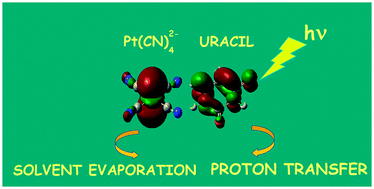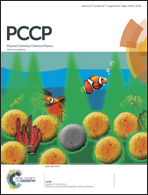Solvent evaporation versus proton transfer in nucleobase–Pt(CN)4,62− dianion clusters: a collisional excitation and electronic laser photodissociation spectroscopy study†‡
Abstract
Isolated molecular clusters of adenine, cytosine, thymine and uracil with Pt(CN)62− and Pt(CN)42− were studied for the first time to characterize the binding and reactivity of isolated transition metal complex ions with nucleobases. These clusters represent model systems for understanding metal complex–DNA adducts, as a function of individual nucleobases. Collisional excitation revealed that the clusters decay on the ground electronic surface by either solvent evaporation (i.e. loss of a nucleobase unit from the cluster) or via proton transfer from the nucleobase to the dianion. The Pt(CN)62−–nucleobase clusters decay only by solvent evaporation, while the Pt(CN)42− clusters fragment by both pathways. The enhanced proton-transfer reactivity of Pt(CN)42− is attributed to the higher charge-density of the ligands in this transition metal anion. % fragmentation curves of the clusters reveal that the adenine clusters display distinctively higher fragmentation onsets, which are traced to the propensity of adenine to form the shortest intercluster H-bond. We also present laser electronic photodissociation measurements for the Pt(CN)62−·Ur, Pt(CN)42−·Ur and Pt(CN)42−·Ur2 clusters to illustrate the potential of exploring metal complex DNA photophysics as a function of nucleobase within well-defined gaseous clusters. The spectra reported herein represent the first such measurements. We find that the electronic excited states decay with production of the same fragments (associated with solvent evaporation and proton transfer) observed upon collisional excitation of the electronic ground state, indicating ultrafast deactivation of the excited-state uracil-localized chromophore followed by vibrational predissociation.


 Please wait while we load your content...
Please wait while we load your content...